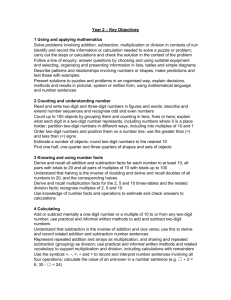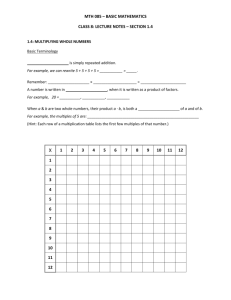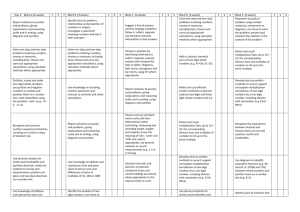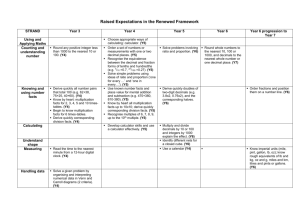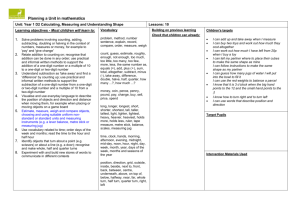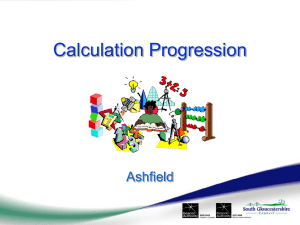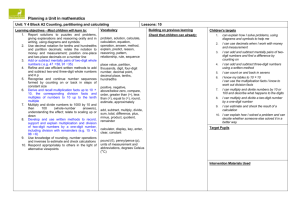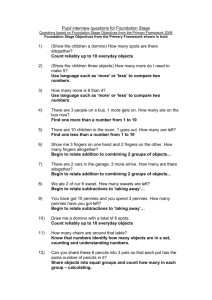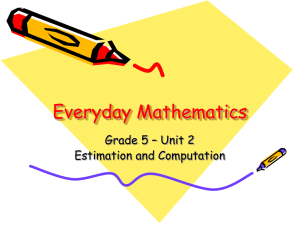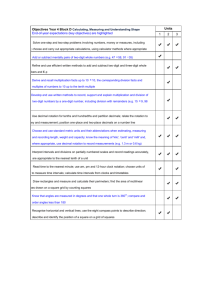Teacher Assessment `Best Fit` Document
advertisement
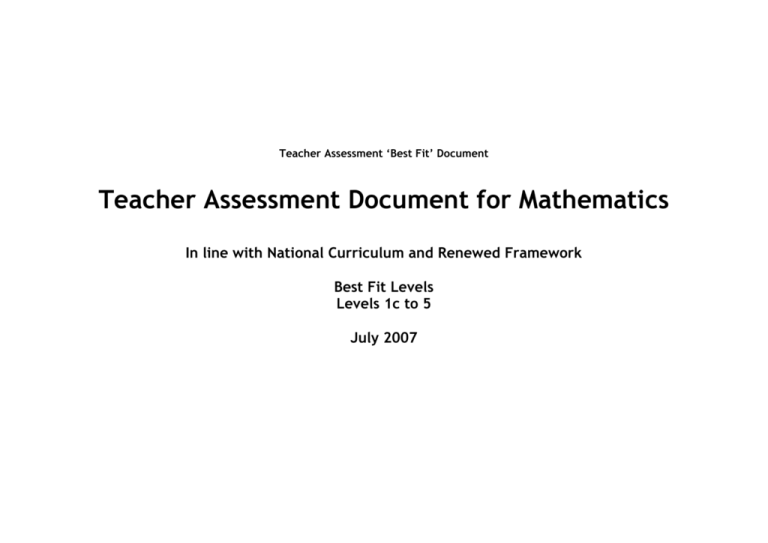
Teacher Assessment ‘Best Fit’ Document Teacher Assessment Document for Mathematics In line with National Curriculum and Renewed Framework Best Fit Levels Levels 1c to 5 July 2007 Teacher Assessment ‘Best Fit’ Document Key YR key objectives Y1 Key objectives Y2 Key objectives Y3 Key objectives Y4 Key objectives Y5 Key objectives Y6 Key objectives Y6/7 Key objectives ***** a repeated objective Teacher assessment should always be a best fit judgement using all available information. This guidance is not a checklist and does not in any way replace the need for teachers to moderate their judgements with other teachers. It is expected that evidence of children’s attainment will be in their books and appropriate records kept by the teacher e.g. pupil discussion records. The purpose of this document is that it is used alongside the evidence base to determine a pupil’s level of attainment through the use of a best fit model. Teacher Assessment ‘Best Fit’ Document Counting, partitioning and calculating 1c Recognise numerals 1 to 9. This is to be used as a best fit model. Say and use number names in familiar contexts. Count reliability at least 10 objects. Attempt to record numbers up to 10. Count out loud from zero to 10 and beyond. Securing number facts, understanding shape Find one more and one less than the given number of objects from 1 to 10. Derive and recall all pairs of numbers with a total of ten and addition facts for totals to at least five. Handling Data and measures Sort objects and shapes in activities. Sort coins and use them in role play. Calculating, measuring and understanding shape Use language such as more or less, greater or smaller heavier or lighter to compare two numbers or quantities. Securing number facts, relationships and calculating Begin to relate addition to combining two groups of objects and subtraction to ‘taking away’. Find one more and one less than the given number of objects from 1 to 10. Know the meaning of plus, more than, less than. Work out the corresponding subtraction facts. Use every day words to describe position such as between, in front of or in the middle. Know the meaning of plus, more than, less than. Begin to use their knowledge of shape to describe the properties of everyday objects. Construct 3D shapes. Recognise and name 2D shapes such as circle, triangle and square. Recognise and name 3D shapes – cube, cuboid, sphere and cylinder. Begin to know some number facts up to 10, e.g. 5 + 5. Begin to use the symbols +, - and =. Generally a child working at level 1c works in very practical, resource based way with numbers to 10. They understand addition as combining two groups and subtraction as taking away. They may be able to add and subtract one from a number mentally. Their recording is mainly pictorial with numbers but not symbols. Their main calculating strategy is counting in 1’s using practical resources e.g. biscuits, cubes, plastic animals. When operating with numbers larger than 10 they have no sense of the answer. Teacher Assessment ‘Best Fit’ Document Counting, partitioning and calculating 1b Use the vocabulary related to addition. This is Use the vocabulary related to to be subtraction. used as a Say the number that is one more than best any given number. fit Estimate a number of objects that can model. be checked by counting. Securing number facts, understanding shape Use the vocabulary related to addition. Use the vocabulary related to subtraction. Use 2D and 3D solids to make patterns, pictures and models. Estimate a number of objects that can be checked by counting. Compare and order numbers using the related vocabulary. Say the number that is one more than any given number. Use practical methods to support the addition of a one-digit number or a multiple of 10 to a one-digit or twodigit number. Use diagrams to sort objects into groups according to a given criterion. Use practical methods to support the subtraction from a one-digit number or a multiple of 10 to a one-digit or two-digit number. Use practical methods to support the addition of a one-digit number or a multiple of 10 to a one-digit or twodigit number. Use practical methods to support the subtraction from a one-digit number or a multiple of 10 to a one-digit or two-digit number. Recall the doubles of all number to at least 10. Handling Data and measures Answer a question by recording information in lists and tables. Present outcomes using practical resources, pictures, block graphs or pictograms. Use diagrams to sort objects into groups according to a given criterion. Estimate a number of objects that can be checked by counting. Calculating, measuring and understanding shape Securing number facts, relationships and calculating Estimate, measure, weigh and compare objects choosing and using suitable uniform nonstandard or standard units and measuring instruments (e.g. a lever balance, metre stick or measuring jug). Use the vocabulary related to addition. Use the vocabulary related to time. Use the vocabulary related to subtraction. Count on in ones. Count on in twos. Count on in fives. Count on in tens. Order days of the week. Use practical methods to support the addition of a onedigit number or a multiple of 10 to a one-digit or two-digit number. Use practical methods to support the subtraction from a one-digit number or a multiple of 10 to a one-digit or two-digit number. Estimate a number of objects that can be checked by counting. Generally a child working at level 1b is confident in working, in a practical way, with numbers to 10 and is beginning to know some ‘teens’ numbers and multiples of 10. They still calculate very practically but may also choose to use their fingers or number line to help them calculate. They are beginning to record their thinking, sometimes using symbols. Children working at 1b have a fuller knowledge of the content of level 1 than those working at 1c but not as extensive as those working at 1a. Teacher Assessment ‘Best Fit’ Document Counting, partitioning and calculating 1a This is to be used as a best fit model. Read numbers from 0 to 20 then beyond. Write the numbers 0 to 20 then beyond. Use knowledge of place value to position these numbers on a number track and number line. Use symbols to describe and record addition number sentences. Use symbols to describe and record subtraction number sentences. Count reliable at least 20 objects. Recognise that when rearranged the number of objects stays the same. Use the equals (=) sign. Say the number that is one less than any given number. Relate addition to counting on. Recognise that addition can be done in any order. Understand subtraction as ‘take away’. Understand subtraction as finding a difference by counting up. Say the number that is ten more than any given number for multiples of ten. Say the number that is ten less than any given number for multiples of ten. Use practical and informal written methods to support the addition of a one-digit number or a multiple of 10 to a one-digit or two-digit number. Use practical and informal written methods to support the subtraction from a one-digit number or a multiple of 10 to a one-digit or twodigit number. Securing number facts, understanding shape Derive and recall all pairs of numbers with a total of 10. Derive and recall addition facts for totals to at least 5. Work out the corresponding subtractions facts. Visualise and name common 2D shapes and 3D solids and describe their features. Use symbols to describe and record addition number sentences. Use symbols to describe and record subtraction number sentences. Read numbers from 0 to 20 then beyond. Write the numbers 0 to 20 then beyond. Use knowledge of place value to position these numbers on a number track and number line. Suggest a different criterion for grouping the same objects. Recall the doubles of all numbers to at least 10. Relate addition to counting on. Recognise that addition can be done in any order. Use practical and informal written methods to support the addition of a one-digit number or a multiple of 10 to a one-digit or two-digit number. Visualise and use everyday language to describe the position of objects and direction and distance when moving them e.g. when placing or moving objects on a game board. Use practical and informal written methods to support the addition of a one-digit number or a multiple of 10 to a one-digit or two-digit number. Use practical and informal written methods to support the subtraction from a one-digit number or a multiple of 10 to a one-digit or two-digit number. Count on or back in ones, twos, fives and tens and use this knowledge to derive the multiples of 2, 5 and 10 to the tenth multiple. Identify objects that turn about a shape e.g. scissors, or about a line e.g. a door. Recognise and make whole, half and quarter turns. Understand subtraction as ‘take away’. Und Count reliable at least 20 objects. Recognise that when rearranged the number of objects stays the same. Say the number that is one less than any given number. Say the number that is ten more than any given number for multiples of ten. Say the number that is ten less than any given number for multiples of ten. Handling Data and measures Calculating, measuring and understanding shape Estimate, measure, weigh and compare objects choosing and using suitable uniform non-standard or standard units and measuring instruments (e.g. a lever balance, metre stick or measuring jug). Suggest a different criterion for grouping the same objects. Answer a question by recording information in lists and tables; present outcomes using practical resources pictures, block graphs or pictograms. Order months of the year. Read the time to the hour. Read the time to the half hour. Count reliable at least 20 objects. Recognise that when rearranged the number of objects stays the same. Relate addition to counting on. Recognise that addition can be done in any order. Use practical and informal written methods to support the addition of a one-digit number or a multiple of 10 to a one-digit or two-digit number. Use practical and informal written methods to support the subtraction from a onedigit number or a multiple of 10 to a one-digit or twodigit number. Understand subtraction as ‘take away’. Understand subtraction as finding a difference by counting up. Visualise and use everyday language to describe the position of objects and direction and distance when moving them e.g. when placing or moving objects on a game board. Securing number facts, relationships and calculating Use symbols to describe and record addition number sentences. Use symbols to describe and record subtraction number sentences. Count on in ones. Count on in twos. Count on in fives. Count on in tens. Use knowledge of counting on and back to derive multiples of 2, 5, and 10 to the tenth multiple. Visualise and use everyday language to describe the position of objects and direction and distance when moving them e.g. when placing or moving objects on a game board. Describe some properties of 2D shapes using everyday language Describe some properties of 3D shapes using everyday language. Solve practical problems that involve combining groups of 2, 5 or 10. Solve practical problems that involve sharing into equal groups. Use the vocabulary of halves and quarters in context. Generally a child working at 1a has a good knowledge and understanding of numbers to 20 and beyond, the teen numbers and the place value involved. They are able to place these on a number line. They are beginning to use symbolic recording of calculations. They are beginning to know some number facts such as pairs of numbers to 10 and doubles to 5 or 10 and halves from 10. They recognise and use simple patterns or relationships. Teacher Assessment ‘Best Fit’ Document Counting, partitioning and calculating 2c Mentally add a one-digit number or a multiple of 10 to or from any twodigit number. This is to be Mentally subtract a one-digit number used or a multiple of 10 to or from any as a two-digit number. best fit Read two-digit numbers in figures. model. Read two-digit numbers in words. Write two-digit numbers in figures. Extend number sequences. Securing number facts, understanding shape Derive and recall all addition facts for each number to at least 10. Suggest a different criterion for grouping the same objects. Beginning to link everyday language with mathematical language e.g. angle, point. Visualise common 2D shapes and 3D solids. Identify shapes from pictures in different positions and orientations. Sort, make and describe shapes referring to their properties. Use correct terms for common 2D shapes – as 1c but including hexagon. Handling Data and measures Calculating, measuring and understanding shape Securing number facts, relationships and calculating Use diagrams to sort objects into groups according to a given criterion. Mentally add a one-digit number or a multiple of 10 to or from any two-digit number. Use facts to add or subtract pairs of numbers mentally. Mentally subtract a one-digit number or a multiple of 10 to or from any two-digit number. Read the time to the quarter hour. Add 1 and 10 to any 2-digit number using a number line for support. Subtract 1 and 10 to any 2-digit number using a number line for support. Solve addition and subtraction problems using a suitable strategy, e.g. number line or unstructured number line to count or hop on or back. Use counting or resources such as number lines, hundred squares rather than known facts to work out problems. Recall the doubles of all numbers to at least 10. Use correct terms for common 3D shapes – as 1c but including pyramid. Read two-digit numbers in figures. Read two-digit numbers in words. Write two-digit numbers in figures. Extend number sequences. Generally a child working at level 2c can still be dependant on iconic or pictorial recording, but they are beginning to read and interpret symbols such as +, - and =. They often use practical resources or adult support to work out anything other than simple calculations or one-step problems. They are not yet confident in using their existing knowledge to generate new facts. Teacher Assessment ‘Best Fit’ Document Counting, partitioning and calculating 2b Count up to 100 objects by grouping them and counting in tens, fives or twos. This is to be Explain what each digit in a two-digit used number represents including as a numbers where 0 is a place holder. best fit Partition 2 digit numbers in different model. ways including into multiples of ten and one. Use practical and informal written methods to add two digit numbers. Use practical and informal written methods to subtract two digit numbers. Read three-digit numbers in figures. Securing number facts, understanding shape Handling Data and measures Derive all subtraction facts for each number to at least 10. Use lists tables and diagrams to sort objects. Recall all subtraction facts for each number to at least 10. Explain choices using appropriate language including ‘not’. Derive all pairs of multiples of 10 with totals up to 100. Recall all pairs of multiples of 10 with totals up to 100. Understand that halving is the inverse of doubling. Derive doubles of all numbers to 20 and the corresponding halves. Recall doubles of all numbers to 20 and the corresponding halves. Read three-digit numbers in words. Derive and recall all pairs with totals to 20. Write three-digit numbers in figures. Recognise multiples of 2, 5 and 10. Describe number words. Read three-digit numbers in figures. Recognise odd and even numbers. Order two-digit numbers and position them on a number line. Estimate a number of objects. Round two digit numbers to the nearest ten. Read three-digit numbers in words. Write three-digit numbers in words. Describe number sequences. Recognise odd and even numbers. Visualise common 2D shapes and 3D solids. Identify shapes from pictures of them in different positions and orientations. Make and describe shapes referring to their properties. Answer a question by collecting and recording data in lists and tables. Represent the data as block graphs or pictograms to show results. Use ICT to organise and present data. Calculating, measuring and understanding shape Securing number facts, relationships and calculating Use practical and informal written methods to add two digit numbers. Needs to use resources such as number lines or hundred squares for problems involving 2-digit numbers with bridging. Use practical and informal written methods to subtract two digit numbers. Find one half, one quarter and three quarters of shapes and sets of objects. Follow and give instructions involving position, direction and movement. Use units of time (seconds, minutes, hours, days) and know the relationships between them. Represent repeated addition and arrays as multiplication. Represent sharing and repeated subtraction (grouping) as division. Use practical methods and related vocabulary to support multiplication and division, including calculations with remainders. Estimate, measure and compare lengths, choosing and using standard units (m, cm, kg, litre) and suitable measuring instruments. Estimate, measure and compare lengths, choosing and using standard units (m, cm, kg, litre) and suitable measuring instruments. Understand that halving is the inverse of doubling. Estimate, measure and compare weights, choosing and using standard units (m, cm, kg, litre) and suitable measuring instruments. Estimate, measure and compare weights, choosing and using standard units (m, cm, kg, litre) and suitable measuring instruments. Recall doubles of all numbers to 20 and the corresponding halves. Estimate, measure and compare capacities, choosing and using standard units (m, cm, kg, litre) and suitable measuring instruments. Estimate, measure and compare capacities, choosing and using standard units (m, cm, kg, litre) and suitable measuring instruments. Derive doubles of all numbers to 20 and the corresponding halves. Find one half, one quarter and three quarters of shapes and sets of objects. Recognise and use whole, half and quarter turns both clockwise and anti-clockwise. Use properties such as faces, edges, sides and corners. Identify reflective symmetry in patterns in 2D shapes. Draw lines of symmetry in 2D shapes. Generally a child working at level 2b knows a wide range of number facts and can recall knowledge of other aspects of the mathematics curriculum more effectively than a child at level 2c but cannot use and apply that knowledge and derive new knowledge as effectively as a child working at 2a and beyond. Teacher Assessment ‘Best Fit’ Document 2a Counting, partitioning and calculating Securing number facts, understanding shape Calculate the value of an unknown in a number sentence (? ÷ 2 = 6, 30 - ? = 24). Derive and recall the multiplication facts for the 2, times tables. This is to be used Use the symbols +, -, x, ÷ as a and = to record and best interpret number fit sentences involving all four model. operations. Derive and recall the multiplication facts for the 5, times tables. Derive and recall the multiplication facts for the 10, times tables. Derive and recall the division facts for the 2 times tables. Use the greater than (>) and less than (<) signs. Derive and recall the division facts for the 5 times tables. Understand that subtraction is the inverse of addition and vice versa. Derive and recall the division facts for the 10 times tables. Use inverse to derive and record related addition and subtraction number sentences. Count on from and back to zero in single-digit steps or multiples of 10. Represent repeated addition and arrays as multiplication. Represent sharing as repeated subtraction (grouping) as division. Read two digit and three digit numbers in figures and words. Write two digit and three digit numbers in figures and words. Use knowledge of number facts and operations to estimate and check answers to calculations. Handling Data and measures Calculating, measuring and understanding shape Read the numbered divisions on a scale and interpret the divisions between them (e.g. on a scale from 0 to 25 with intervals of 1 shown but only the divisions 0, 5, 10 numbered). Read the numbered divisions on a scale and interpret the divisions between them (e.g. on a scale from 0 to 25 with intervals of 1 shown but only the divisions 0, 5, 10 numbered). Use a ruler to draw and measure lines to the nearest cm. Use a ruler to draw and measure lines to the nearest cm. Identify time intervals including those that cross the hour. Read and record the vocabulary of position, direction and movement. Know that a right angle represents a quarter turn. Securing number facts, relationships and calculating Calculate the value of an unknown in a number sentence (? ÷ 2 = 6, 30 - ? = 24). Use the symbols +, -, x, ÷ and = to record and interpret number sentences involving all four operations. Bridge through tens numbers when adding or subtracting using appropriate strategies. Can solve simple x and ÷ problems by pictorial or informal jottings/methods. Describe and extend number sequences and recognise odd and even numbers. Use the greater than (>) and less than (<) signs. Recognise subtraction is the inverse of addition and use this to derive and record related addition and subtraction number sentences. Identify and estimate fractions of shapes. Know that a right angle represents a quarter turn. Use diagrams to compare fractions and establish equivalents. Identify and estimate fractions of shapes. Use informal written methods and related vocabulary to support multiplication and division, including calculations with remainders. Relate 2-D shapes and 3-D solids to drawings of them. Describe the 2-D and 3-D shapes. Visualise the 2-D and 3-D shapes. Classify the 2-D and 3-D shapes. Draw and make the 2-D and 3-D shapes. Derive and recall the multiplication facts for the 2, times tables. Derive and recall the multiplication facts fro the 5, times tables. Derive and recall the multiplication facts for the 10, times tables. Derive and recall the division facts for the 2 times tables. Derive and recall the division facts for the 5 times tables. Derive and recall the division facts for the 10 times tables. Generally a child working at level 2a has a good knowledge and understanding of the mathematical content of level 2 and is beginning to use and apply what they know and can derive some new facts. They are more able to use abstract number and are beginning to manipulate numbers in calculations. They are usually secure with +/- strategies and are beginning to work with x/÷. They can explain why an answer is correct. Their knowledge and understanding of the content at level 3 is limited to a few aspects so that they cannot always answer questions at this level due to lack of content knowledge or sophistication of thinking and reasoning when faced with unfamiliar problems. Teacher Assessment ‘Best Fit’ Document Counting, partitioning and calculating 3c This is to be used as a best fit model. Partition three-digit numbers into multiples of 100, 10 and 1 in different ways. Derive and recall all + facts for each number to 20. Derive and recall all – facts for each number to 20. Derive and recall sums and differences of multiples of 10. Derive and recall number pairs that total 100. Add or subtract mentally combinations of one-digit and two-digit numbers. Multiply one-digit and two-digit numbers by 10 or 100, and describe the effect. Read whole numbers to at least 1000 and position them on a number line. Write whole numbers to at least 1000 and position them on a number line. Order whole numbers to at least 1000 and position them on a number line. Develop and use written methods to record, support or explain addition and subtraction of two-digit and three-digit numbers. Derive and recall multiplication facts for the 2, 5 and 10 times tables and the corresponding division facts. Recognise and continue number sequences formed by counting on or back in steps of constant size. Represent repeated addition and arrays as multiplication. Represent sharing as repeated subtraction (grouping) as division. Securing number facts, understanding shape Handling Data and measures Use knowledge of number operations and corresponding inverses, including doubling and halving to estimate and check calculations. Interpret intervals and divisions on partially numbered scales and record readings accurately, where appropriate to the nearest tenth of a unit. (e.g. scale marked 0-1kg with 200 intervals and arrow roughly between 400g & 600g, the number would read approx 550g). Securely use knowledge of number facts and operations to estimate and check answers to calculations. Draw and complete shapes with reflective symmetry. Draw the reflection of shapes in a mirror line along one side. Read and write proper fractions (e.g. 3/7, 9/10), interpreting the denominator as the parts of a whole and the numerator as the number of parts. Use diagrams to compare fractions and establish equivalents. Derive and recall all + facts for each number to 20. Derive and recall all – facts for each number to 20. Derive and recall sums and differences of multiples of 10. Derive and recall number pairs that total 100. Report solutions to puzzles and problems giving explanations and reasoning orally. Use practical and informal written methods and related vocabulary to support multiplication and division including calculations with remainders. Identify the doubles of two-digit numbers; use these to calculate doubles of multiples of 10 and 100 and derive the corresponding halves. Identify the doubles of two-digit numbers; use these to calculate doubles of multiples of 10 and 100 and derive the corresponding halves. Visualise 3-D objects from 2-D drawings. Read to the nearest division and half division scales that are numbered or partially numbered; use the information to measure and draw to a suitable degree of accuracy. Use Venn diagrams or Carroll diagrams to sort data and objects using more than one criterion. Calculating, measuring and understanding shape Securing number facts, relationships and calculating Recognise and use whole, half and quarter turns, both clockwise and anti-clockwise. Partition three-digit numbers into multiples of 100, 10 and 1 in different ways. Plot points on a grid. Read and write proper fractions (e.g. 3/7, 9/10), interpreting the denominator as the parts of a whole and the numerator as the number of parts. Use a set square to draw and to identify right angles in 2D shapes. Compare angles to a right angle. Interpret intervals and divisions on partially numbered scales and record readings accurately, where appropriate to the nearest tenth of a unit. (e.g. scale marked 0-1kg with 200 intervals and arrow roughly between 400g & 600g, the number would read approx 550g). Read time to the nearest minute; use am, pm and 12-hour clock notation. Choose units of time to measure time intervals. (e.g. how long do you spend at school each day? How long do you play computer games each day?). Identify pairs of fractions that total 1. Find unit fractions of numbers and quantities e.g. ½, 1/3, ¼, 1/5, 1/10 of shapes and numbers. Derive and recall all + facts for each number to 20. Derive and recall all – facts for each number to 20. Derive and recall sums and differences of multiples of 10. Derive and recall number pairs that total 100. Multiply one-digit and two-digit numbers by 10 or 100, and describe the effect. Draw rectangles and measure their perimeters. Understand ÷ as inverse of multiplication and vice versa. Find the area of rectilinear shapes drawn on a square grid by counting squares. Estimate a proportion (e.g. about one quarter of the apples in the box are green). Use the four compass directions to describe movement about a grid. Recognise horizontal and vertical lines. Generally a child working at level 3c has experience of working with numbers beyond 100 for sequencing, partitioning counting on and rounding. They have developed informal strategies to calculate when adding or subtracting and no longer rely on counting in ones. For example to add 23 to a number they can add 10, 10 and 3 and they can explain what they are doing. They are beginning to understand division as sharing and grouping. They have developed an understanding of multiplication and have begun to know simple multiplication facts by heart. They are able to choose an appropriate strategy to solve one step problems and some two step problems and work systematically. Teacher Assessment ‘Best Fit’ Document Securing number facts, understanding shape Counting, partitioning and calculating 3b Develop and use written methods to record, Derive and recall the multiplication facts for the 2, 3, 4, 5, 6 and 10 times tables and the corresponding division facts for 2, 5 or 10 up to 1000. Read and record the vocabulary of position, direction and movement using the four compass directions to describe movement about a gird. Classify 2D and 3D shapes using mathematical properties. Sketch a simple reflection. Complete patterns with up to two lines of symmetry. Recognise horizontal and vertical lines. Use knowledge of rounding, number operations and inverses to estimate and check calculations. Use knowledge of addition and subtraction facts and place value to derive sums and differences of pairs of multiples of 10, 100 or 1000. Make nets of common solids. support and explain multiplication and division This is of two-digit numbers by a one-digit number to be including division with remainders (e.g. 15 x 9 used or 98 ÷ 6). as a Add or subtract mentally pairs of two-digit best whole numbers, (e.g. 47 + 58, 91 – 35). fit Order four digit whole numbers. model. Partition four digit whole numbers. Round two-digit or three-digit numbers to the nearest 10 or 100 and give estimates for their sums and differences. Derive and recall the multiplication facts for the 2, 3, 4, 5, 6 and 10 times tables and the corresponding division facts for 2, 5 or 10 up to 1000. Recognise multiples of 2, 5 or 10 up to 1000. Use knowledge of addition and subtraction facts and place value to derive sums and differences of pairs of multiples of 10, 100 or 1000. Use practical and informal written methods to multiply and divide two-digit numbers (e.g. 13 x 3 or 50 ÷ 4); round remainders up or down depending on the context. Relate decimal notation to money and measurement. Use decimal notation for tenths and hundredths. Partition decimals. Use positive and negative numbers in context and position them on a number line. Refine and use efficient methods to add and subtract two-digit and three-digit whole numbers and £ p. Use a calculator to carry out one-step and twostep calculations involving all four operations. Recognise negative numbers in a calculator display. Correct mistaken entries on a calculator. Interpret a calculator display in the context of money. Use knowledge of rounding, number operations and inverses to estimate and check calculations. Handling Data and measures Calculating, measuring and understanding shape Securing number facts, relationships and calculating Answer a question by identifying what data to collect; organise present analyse and interpret the data in tables diagrams, tally charts, pictograms and bar charts using ICT where appropriate. Choose and use standard metric units and their abbreviations when estimating, measuring and recording length. Choose and use standard metric units and their abbreviations when estimating, measuring and recording weight. Choose and use standard metric units and their abbreviations when estimating, measuring and recording capacity. Know the meaning of ‘kilo’, ‘centi’ and ‘mili’. Where appropriate be able to use decimal notation to record measurements (e.g. 1.3m or 0.6kg). Plot position on a grid. Compare the impact of representations where scales have intervals of differing step size. Know that angles are measured in degrees and that one whole turn in 3600. Compare and order angles less than 1800. Plot position on a grid. Compare angles to a right angle. Recognise that a straight line is equivalent to two right angles. Add or subtract mentally pairs of two-digit whole numbers, (e.g. 47 + 58, 91 – 35). Refine and use efficient methods to add and subtract two-digit and three-digit whole numbers and £ p. Develop and use written methods to record support and explain multiplication of two-digit numbers by a one-digit number (e.g. 15 x 9). Develop and use written methods to record support and explain division of two-digit numbers by a one-digit number including division with remainders (e.g. 98 ÷ 6). Choose and use standard metric units and their abbreviations when estimating, measuring and recording length. Choose and use standard metric units and their abbreviations when estimating, measuring and recording weight. Choose and use standard metric units and their abbreviations when estimating, measuring and recording capacity. Know the meaning of ‘kilo’, ‘centi’ and ‘mili’. Where appropriate be able to use decimal notation to record measurements (e.g. 1.3m or 0.6kg). Calculate time intervals from clocks and timetables. Relate decimal notation to money and measurement. Use decimal notation for tenths and hundredths. Partition decimals. Use the eight compass points to describe direction. Describe and identify the position of a square on a grid of squares. Complete patterns with up to two lines of symmetry. Develop and use written methods to record, support and explain multiplication of two-digit numbers by a one-digit number (e.g. 15 x 9). Develop and use written methods to record, support and explain division of two-digit numbers by a one-digit number including division with remainders (e.g. 98 ÷ 6). +/- mentally 2 digit numbers using known facts and place value. Add and subtract numbers with 3digits using written methods. Derive and recall the multiplication facts for the 2, 3, 4, 5, 6 and 10 times tables and the corresponding division facts for 2, 5 or 10 up to 1000. Develop and use written methods to record, support or explain addition and subtraction of 2-digit and 3-digit numbers. Use practical and informal written methods to multiply and divide twodigit numbers (e.g. 13 x 3 or 50 ÷ 4); round remainders up or down depending on the context. Use understanding of inverse to derive and record related multiplication and division number sentences. Recognise the equivalence between decimal and fraction forms of one half, quarters, tenths and hundredths. Find unit fractions of numbers and quantities (e.g. ½, 1/3, ¼, 1/16, or 12 litres). Use the vocabulary of ration and proportion to describe the relationship between two quantities (e.g. there are two red beads to every three beads, or two beads in every five beads are red). Generally a child working at level 3b can work more confidently with numbers beyond 100 and probably beyond one thousand. They solve two step problems using informal methods and explain their reasoning using jottings. Their understanding of division is developing and they can relate their answers to the situation. They can use a strategy such as doubling to explain the relationship between multiplication tables e.g. 2x and 4x or 5x and 10x. They can explain commutative property of multiplication using pictures or diagrams. They are beginning to use a systematic approach to problems. They read and use scales accurately when measuring length, weight and capacity. Teacher Assessment ‘Best Fit’ Document 3a This is to be used as a best fit model. Counting, partitioning and calculating Securing number facts, understanding shape Handling Data and measures Calculating, measuring and understanding shape Securing number facts, relationships and calculating Derive multiplication facts for up to 10 times 10 Recall multiplication facts for up to 10 times 10. Derive division facts for up to 10 times 10. Recall division facts for up to 10 times 10. Use efficient written methods to add and subtract whole numbers and decimals with up to two places. Round four digit whole numbers. Use practical and informal written methods to multiply two-digit numbers, rounding up or down depending on the context. Use practical and informal written methods to divide two-digit numbers, rounding up or down depending on the context. Position one place and two place decimals on a number line. Count from any given number in whole number and decimal steps, extending beyond zero when counting backwards; relate the numbers to their position on a number line. State inequalities using the symbols < and > (e.g. -3 is > -5, -1 < +1) Extend mental methods for whole number calculations, for example to multiply a two-digit by a one-digit number (e.g. 12 x 9), to multiply by 25 (e.g. 16 x 25), and to subtract one near multiple of 1000 from another (e.g. 6070 – 4097). Use a calculator to solve problems, including those involving decimals or fractions (e.g. find ¾ of 150g); interpret the display correctly in given contexts. Derive multiplication facts for up to 10 times 10 Recall multiplication facts for up to 10 times 10. Derive division facts for up to 10 times 10. Recall division facts for up to 10 times 10. Use efficient written methods to add and subtract whole numbers and decimals with up to two places. Use a calculator to solve problems, including those involving decimals or fractions (e.g. find ¾ of 150g); interpret the display correctly in given contexts. Draw polygons and classify them by identifying their properties including their line symmetry. Identify, visualise and describe properties of rectangles, triangles, regular polygons and 3D solids. Use knowledge of properties to draw 2D shapes and identify and draw nets of 3D shapes. Draw the position of a shape after a reflection or translation. Construct frequency tables, pictograms and bar and line graphs to represent the frequencies of events and changes over time. Answer a set of related questions by collecting, selecting and organising relevant data; draw conclusions, using ICT to present features and identify further questions to ask. Describe the occurrence of familiar events using the language of chance or likelihood. Read, choose, use and record standard metric units to estimate and measure length, weight and capacity to a suitable degree of accuracy (e.g. the nearest ½ cm). Derive multiplication facts for up to 10 times 10 Recall multiplication facts for up to 10 times 10. Derive division facts for up to 10 times 10. Recall division facts for up to 10 times 10. Know that angles are measured in degrees and that one whole turn is 360 degrees; compare and order angles less than 180 degrees. Use efficient written methods to add and subtract whole numbers and decimals with up to two places. Read and plot co-ordinates in the first quadrant Position one place and two place decimals on a number line. Use a calculator to solve problems, including those involving decimals or fractions (e.g. find ¾ of 150g); interpret the display correctly in given contexts. Draw the position of a shape after a reflection or translation. Estimate, draw and measure acute and obtuse angles using an angle measurer or protractor to a suitable degree of accuracy. Calculate angles in a straight line. Read, choose, use and record standard metric units to estimate and measure length, weight and capacity to a suitable degree of accuracy (e.g. the nearest cm). Read timetables and time using 24 hour clock notation. Use a calendar to calculate time intervals. Calculate the perimeter and area of rectilinear shapes. Estimate the area of an irregular shape by counting squares. Interpret mixed numbers and position them on a number line (e.g. 3½). Derive multiplication facts for up to 10 times 10 Recall multiplication facts for up to 10 times 10. Derive division facts for up to 10 times 10. Recall division facts for up to 10 times 10. Find fractions of number, quantities or shapes (e.g. 1/5 of 30 plums, 3/8 of a 6 by 4 rectangle). Use diagrams to identify equivalent fractions e.g. 6/8 and ¾ or 70/100 and 7/10; interpret mixed numbers and position them on a number line e.g. 3½. Explain reasoning using diagrams, graphs and text. Extend mental methods for whole number calculations, for example to multiply a two-digit by a one-digit number (e.g. 12 x 9), to multiply by 25 (e.g. 16 x 25), and to subtract one near multiple of 1000 from another (e.g. 6070 – 4097). Use a calculator to solve problems, including those involving decimals or fractions (e.g. find ¾ of 150g); interpret the display correctly in given contexts. Generally a child working at level 3a has a good knowledge and understanding of the mathematical content of level 3. They are beginning to use decimal notation and to use negative numbers in context. They can count on in unit fractions. They begin to use mathematics to communicate information they have gathered. They are beginning to consider different approaches and find ways of overcoming difficulties that arise when they are solving problems. They are beginning to organise their work and check results. They begin to justify their choice of strategy. They can find a particular case of a general statement. They use and interpret mathematical symbols and diagrams. Teacher Assessment ‘Best Fit’ Document Counting, partitioning and calculating 4c Derive the corresponding division facts and multiples of numbers to 10 up to the This is tenth multiple. (100). to be Recall the corresponding division facts used and multiples of numbers to 10 up to the as a tenth multiple. (100). best Explain what each digit represents in fit whole numbers and decimals with up to model. two places, and partition, round and order these numbers (e.g. what is the value of the 7 in 3 274 105. Use knowledge of place value and addition and subtraction of two-digit numbers to derive sums and differences and doubles and halves of decimals (e.g. 6.5 ÷ 2.7, half of 5.6 double 0.34). Multiply numbers to 1000 by 10 and then 100 (whole number answers), understanding the effect, relate to scaling up or down. Divide numbers to 1000 by 10 and then 100 (whole number answers), understanding the effect, relate to scaling up or down. Recall quickly multiplication facts up to 10 x 10 and use them to multiply pairs of multiples of 10 and 100. Quickly derive division facts that correspond to multiplication facts up to 10 x 10. Identify pairs of factors of two-digit whole numbers and find common multiples (e.g. for 6 and 9). Use understanding of place value to multiply and divide whole numbers and decimals by 10, 100 or 1000. Refine and use efficient written methods to multiply and divide HTU x U, TU x TU, U.t x U and HTU ÷ U. Use knowledge of rounding, place value, number facts and inverse operations to estimate and check calculations. Use a calculator to solve problems involving multi-step calculations. Securing number facts, understanding shape Handling Data and measures Calculating, measuring and understanding shape Securing number facts, relationships and calculating Use knowledge of place value and addition and subtraction of twodigit numbers to derive sums and differences and doubles and halves of decimals (e.g. 6.5 ÷ 2.7, half of 5.6 double 0.34). Recall quickly multiplication facts up to 10 x 10 and use them to multiply pairs of multiples of 10 and 100. Quickly derive division facts that correspond to multiplication facts up to 10 x 10. Identify pairs of factors of two-digit whole numbers and find common multiples (e.g. for 6 and 9). Use knowledge of rounding, place value, number facts and inverse operations to estimate and check calculations. Recognise that prime numbers have only two factors and identify prime numbers less than 100; find the prime factors of two-digit numbers. Use a calculator to solve problems involving multi-step calculations. Describe, identify and visualise parallel and perpendicular edges or faces; use these properties to classify 2-D shapes and 3-D solids. Make and draw shapes with increasing accuracy and apply knowledge of their properties. Find and interpret the mode of a set of data. Construct and interpret frequency tables, bar charts with grouped discrete data, and line graphs; interpret pie charts. Convert larger to smaller units using decimals to one place (e.g. change 2.6 kg to 2600g). Interpret a reading that lies between two unnumbered divisions on a scale. Describe and predict outcomes from data using the language of chance or likelihood. Use a calculator to solve problems involving multi-step calculations. Read and plot co-ordinates in the first quadrant. Recognise parallel and perpendicular lines in grids and shapes. Use a set square and ruler to draw shapes with perpendicular or parallel sides. Draw and measure lines to the nearest millimetre. Measure and calculate the perimeter of regular and irregular polygons. Use the formula for the area of a rectangle to calculate the rectangle’s area. Use knowledge of rounding, place value, number facts and inverse operations to estimate and check calculations. Use understanding of place value to multiply and divide whole numbers and decimals by 10, 100 or 1000. Refine and use efficient written methods to multiply and divide HTU x U, TU x TU, U.t x U and HTU ÷ U. Convert larger to smaller units using decimals to one place (e.g. change 2.6 kg to 2600g). Interpret a reading that lies between two unnumbered divisions on a scale. Use a calculator to solve problems involving multi-step calculations. Use knowledge of place value and addition and subtraction of two-digit numbers to derive sums and differences and doubles and halves of decimals (e.g. 6.5 ÷ 2.7, half of 5.6 double 0.34). Refine ways to recording using images and symbols. Express a smaller whole number as a fraction of a larger one (e.g. recognise that 5 out of 8 is ⅝). Find equivalent fractions (e.g. 7/10= 14/20 or 19/10 = 1 9/10; relate fractions to their decimal representations. Understand percentage as the number of parts in every 100 and express tenths and hundredths as percentages. Use sequences to scale numbers up or down; solve problems involving proportions of quantities (e.g. decrease quantities in a recipe designed to feed six people). Recall quickly multiplication facts up to 10 x 10 and use them to multiply pairs of multiples of 10 and 100. Quickly derive division facts that correspond to multiplication facts up to 10 x 10. Identify pairs of factors of two-digit whole numbers and find common multiples (e.g. for 6 and 9). Refine and use efficient written methods to multiply and divide HTU x U, TU x TU, U.t x U and HTU ÷ U. Find fractions using division (e.g. 1/100 of 5kg), and percentages of numbers and quantities (e.g. 10%, 5% and 15% of £80). Use a calculator to solve problems involving multi-step calculations. Generally a child working at 4c has experience of numbers to 1 000 000 and of decimals to 2dp. Pupils use their understanding of place value to multiply and divide whole numbers by 10 and 100. They have experience of recognising some equivalence of fractions. They may have only one reliable strategy for each of the four written number operations but have a range of mental methods to draw on. Pupils are developing their own strategies for solving problems. They maintain an appreciation of the reasonableness of an answer when working with larger numbers. Teacher Assessment ‘Best Fit’ Document Counting, partitioning and calculating Securing number facts, understanding shape 4b Use knowledge of place value Use knowledge of place and multiplication facts to 10 x value and multiplication This is 10 to derive related facts to 10 x 10 to derive to be multiplication and division facts related multiplication and used involving decimals (e.g. 0.8 x 7, division facts involving as a 4.8 ÷ 6). decimals (e.g. 0.8 x 7, 4.8 best ÷ 6). Use efficient written methods to fit add and subtract integers and Use knowledge of model. decimals. Use efficient written methods to multiply and divide integers and decimals by a one-digit integer. Multiply two-digit and threedigit integers by a two-digit integer. Find the difference between a positive and a negative integer, or two negative integers, in context. Use decimal notation for tenths, hundredths and thousandths; partition, round and order decimals with up to three places, and position them on the number line. Calculate mentally with integers and decimals: U.t + U.t, TU x U, TU ÷ U, U.t x U, U.t ÷ U. Use approximations, inverse operations and tests of divisibility to estimate and check results. multiplication facts to derive quickly squares of numbers to 12 x 12 and the corresponding squares of multiples of 10. Use approximations, inverse operations and tests of divisibility to estimate and check results. Handling Data and measures Select and use standard metric units of measure and convert between units using decimals to two places (e.g. change 2.75 litres to 2750ml or vice versa). Describe and interpret results and solutions to problems using the mode, range, median and mean. Read and interpret scales on a range of measuring instruments, recognising that the measurement made is approximate and recording results to a required degree of accuracy. Compare readings on different scales, for example when using different instruments. Calculating, measuring and understanding shape Use efficient written methods to add and subtract integers and decimals. Use efficient written methods to multiply and divide integers and decimals by a one-digit integer. Multiply two-digit and three-digit integers by a twodigit integer. Select and use standard metric units of measure and convert between units using decimals to two places (e.g. change 2.75 litres to 2750ml or vice versa). Visualise and draw on grids of different types where a shape will be after reflection, after translations, or after rotation through 900 or 1800 about its centre or one of its vertices. Calculate mentally with integers and decimals: U.t + U.t, TU x U, TU ÷ U, U.t x U, U.t ÷ U. Use approximations, inverse operations and tests of divisibility to estimate and check results. Solve problems by measuring, estimating and calculating. Measure and calculate using imperial units still in everyday use; know their approximate metric values. Read and interpret scales on a range of measuring instruments, recognising that the measurement made is approximate and recording results to a required degree of accuracy. Compare readings on different scales, for example when using different instruments. Estimate angles, and use a protractor to measure and draw them, on their own and in shapes; calculate angles in a triangle or around a point. Use coordinates in the first quadrant to draw, locate and complete shapes that meet given properties. Securing number facts, relationships and calculating Use knowledge of place value and multiplication facts to 10 x 10 to derive related multiplication and division facts involving decimals (e.g. 0.8 x 7, 4.8 ÷ 6). Use efficient written methods to add and subtract integers and decimals. Use efficient written methods to multiply and divide integers and decimals by a one-digit integer. Multiply two-digit and three-digit integers by a two-digit integer. Express one quantity as a percentage of another (e.g. express £400 as a percentage of £1000). Find equivalent percentages, decimals and fractions. Express a larger whole number as a fraction of a smaller one (e.g. recognise that 8 slices of a 5-slice pizza represents 8/5 or 1 3/5 pizzas). Simplify fractions by cancelling common factors. Order a set of fractions by converting them to fractions with a common denominator. Relate fractions to multiplication and division (e.g. 6 ÷ 2 = ½ of 6 = 6 x ½ ). Express a quotient as a fraction or decimal (e.g. 67 ÷ 5 = 13.4 or 13 2/5). Find fractions and percentages of wholenumber quantities (e.g. 5/8 of 96, 65% of £260). Solve simple problems involving direct proportion by scaling quantities up or down. Use a calculator to solve problems involving multi-step calculations. Generally a child working at 4b has more confidence when working with fractions and decimals and can order groups of mixed numbers. They can use the relationship between familiar fractions, decimals and percentages to solve problems. They have a more secure understanding of the connection between number operations which supports a flexible approach to solving problems. They solve problems involving all four operations related to measures including converting between units. They can choose an appropriate strategy for checking answers. When investigating they are able to present information and results in a clear and organised way. Teacher Assessment ‘Best Fit’ Document Counting, partitioning and calculating 4a Use knowledge of place value and multiplication facts to 10 x 10 to derive related multiplication and division facts involving decimals (e.g. 0.8 x 7, 4.8 ÷ 6). This is to be used as a Use efficient written methods to add best and subtract integers and decimals. fit model. Use efficient written methods to multiply and divide integers and decimals by a one-digit integer. Multiply two-digit and three-digit integers by a two-digit integer. Find the difference between a positive and a negative integer, or two negative integers, in context. Calculate mentally with integers and decimals: U.t + U.t, TU x U, TU ÷ U, U.t x U, U.t ÷ U. Use approximations, inverse operations and tests of divisibility to estimate and check results. Securing number facts, understanding shape Use knowledge of place value and multiplication facts to 10 x 10 to derive related multiplication and division facts involving decimals (e.g. 0.8 x 7, 4.8 ÷ 6). Use knowledge of multiplication facts to derive quickly squares of numbers to 12 x 12 and the corresponding squares of multiples of 10. Use approximations, inverse operations and tests of divisibility to estimate and check results. Make and justify estimates and approximations to calculations. Recognise and use multiples, factors, divisors, common factors, highest common factors and lowest common multiples in simple cases. Pupils recognise and describe number patterns and relationships including multiple factor and square. Handling Data and measures Solve problems by collecting selecting processing, presenting and interpreting data, using ICT where appropriate; draw conclusions and identify questions to ask. Calculate the perimeter and area of rectilinear shapes, estimate the area of an irregular shape by counting squares. Calculating, measuring and understanding shape Securing number facts, relationships and calculating Calculate mentally with integers and decimals: U.t + U.t, TU x U, TU ÷ U, U.t x U, U.t ÷ U. Express one quantity as a percentage of another (e.g. express £400 as a percentage of £1000). Use approximations, inverse operations and tests of divisibility to estimate and check results. Find equivalent percentages, decimals and fractions. Use coordinates in the first quadrant to draw, locate and complete shapes that meet given properties. Recognise approximate proportions of a whole and use simple fractions and percentages to describe these. Use a calculator to solve problems involving multi-step calculations. Make and draw shapes with increasing accuracy and apply knowledge of their properties. Describe, identify and visualise parallel and perpendicular edges and faces; use these properties to classify 2D shape and 3D solids. Add and subtract decimals to 2 places, using mixed integers and decimals. Generally a child working at level 4a has a good knowledge and understanding of the mathematical content of level 4. They have confidence with number and can use their understanding of the relationship between operations to identify an efficient strategy to solve a problem. In explanation they use specific mathematical vocabulary e.g. factor, prime, product. They apply their mathematical knowledge across the curriculum. They present information and results in a clear and organised way in order to support their reasoning. They choose when it is appropriate to use a calculator. Teacher Assessment ‘Best Fit’ Document 5 Counting, partitioning and calculating Securing number facts, understanding shape Pupils use their understanding of place value to multiply and divide whole numbers by 10, 100 and 1000. Recognise the square roots of perfect squares to 12 x 12. This is to be Use ratio notation, reduce a ratio to used its simplest form and divide a quantity as a into two parts in a given ratio. best fit Solve simple problems involving ratio model. and direct proportion. Recognise approximate proportions of a whole and use fractions and percentages to describe and compare them e.g. when interpreting pie charts. Use correctly the vocabulary, notation and labelling conventions for lines, angles and shapes. Extend knowledge of properties of triangles and quadrilaterals and use these to visualise and solve problems, explaining reasoning with diagrams. Identify all the symmetries of 2D shapes; transform images using ICT. Handling Data and measures Understand and use the probability scale from zero to one. Find and justify probabilities based on equally likely outcomes in simple contexts. Explore hypotheses by planning surveys or experiments to collect small sets of discrete or continuous data. Construct interpret and compare graphs or diagrams that represent data. Solve problems by measuring estimating and calculating. Measure and calculate using imperial units still in everyday use. Know their approximate metric values. Calculating, measuring and understanding shape Understand how the commutative and associative and distributive laws and the relationships between operations including inverse can be used to calculate more efficiently. Use the order of operations including brackets. Use bracket keys and the memory of a calculator to carry out calculations with more than one step. Use the square root key. Securing number facts, relationships and calculating Consolidate and extend mental methods of calculation to include fractions, decimals and percentages. Calculate percentage increases or decreases and fractions of quantities and measurements. Understand how the commutative and associative and distributive laws and the relationships between operations including inverse can be used to calculate more efficiently. Use the order of operations including brackets. Know the sum of angles on a straight line, in a triangle and at a point, and recognise vertically opposite angles. Construct a triangle given 2 sides and the included angle. Use all four quadrants to find coordinates of points determined by geometric information. Generally a child working at level 5 is competent at using a range of numbers in a variety of contexts. They are successful at making appropriate decisions including whether it is reasonable to use a calculator. Pupils show understanding of situations by describing them mathematically using symbols, words and diagrams. They draw simple conclusions of their own and give an explanation of their reasoning.
